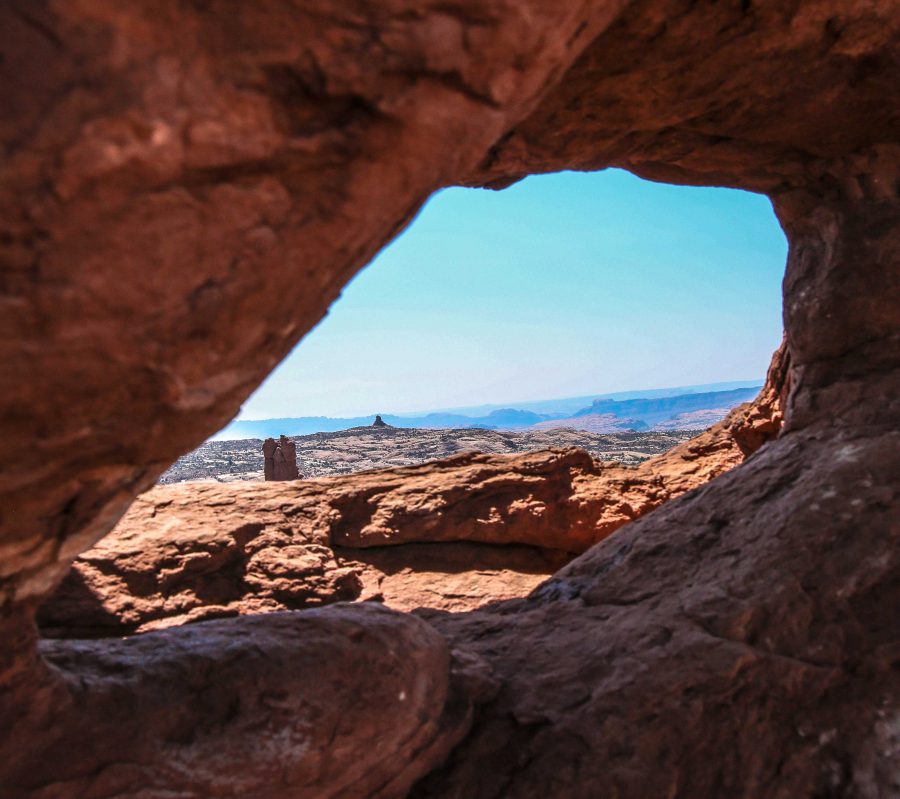Barron: Stay Home from National Parks this Summer
Arches National Park near Moab, Utah. (Photo by Cassandra Palor | Daily Utah Chronical)
June 3, 2020
During winter break, my family and I planned a trip to Yosemite for late July. We booked an Airbnb, discussed how to split up the drive and I set a reminder in my calendar to apply for a hiking permit for Half-Dome months in advance. The same day I entered the permit lottery, COVID-19 claimed its second known victim in the United States. Like most Americans at that point, I had no idea how widespread and severe the COVID-19 pandemic would become.
Now, about three months later, we do. To date, more than 100,000 Americans have died from COVID-19. However, if we had had the foresight to implement social distancing guidelines in the United States just seven days earlier, 35,927 of these deaths could have been prevented. As the country’s National Parks begin to reopen, it is unclear how many lives could be saved if Americans choose to cancel vacation plans and continue social distancing where possible. But considering what is at stake, the only responsible choice is to stay home from National Parks this summer and recreate locally.
The Center for Disease Control (CDC) has released guidelines for outdoor recreation which include maintaining a distance of six feet or more, even on outdoor trails, between hiking parties and avoiding busy areas. While these guidelines are reasonable in most cases, they are an impossibility at popular parks like Utah’s Mighty Five. Prior to the COVID-19 pandemic, Zion National Park attracted more than 4 million people annually, with visitors waiting in hours-long lines for shuttles and at popular trailheads. While Zion, which reopened over Memorial Day weekend, plans to reduce the number of visitors allowed into the park, the park reached maximum capacity before 7:00 a.m. on Memorial Day. Based on previous behavior, it is possible that those denied entry will still try to enter the park. Moreover, according to former park ranger Jon Waterman, it will be almost impossible to enforce social distancing rules, making parks potential COVID-19 hot spots.
When people go to visit the Mighty Five, all of which are located in rural Utah, they put locals’ lives at risk. The Daily Yonder found that infection rates in rural counties “with strong recreation economies [were] more than three times higher than other rural counties,” and most of these counties are ill-equipped for a pandemic. Moab is home to two national parks, but the regional hospital only has three ventilators. More than 5,000 people live in Moab, but the hospital can only care for five people with serious COVID-19 symptoms. As local leaders’ requests for additional guidelines and precautions have been denied by the state, simply choosing to take a vacation could threaten thousands of lives.
Recreational businesses located near national parks may not survive the pandemic, but preserving local economies should not come at the cost of human lives. Luckily, would-be tourists can support rural Utahns and their businesses remotely. Rural communities have been practically left out of federal relief packages. To help these communities weather the economic threats of the pandemic, email your local and national representatives to demand rural Utahns are included in future COVID-19 relief efforts. Additionally, if you are financially able, consider purchasing gift cards from restaurants or excursion services you would want to use when it is safe to visit.
Reducing the spread of COVID-19 does not mean staying inside all summer — instead, we can recreate responsibly closer to home. According to Kate Van Waes, the executive director of the American Hiking Society, hikers should only use trailheads they can drive to without having to make stops. Additionally, Van Waes discourages hiking if the trailhead parking lot is more than half full. As popular trailheads like Mount Olympus and Red Pine Lake may be crowded on sunny weekends, hikers with flexible work schedules should consider hiking during the week. It is also critical to follow social distancing guidelines as closely as possible on trails and wear masks when that is not possible or reasonable to expect. Applying these guidelines to almost every recreational activity will be integral in keeping our communities safe. However, higher-risk activities like rock climbing and mountain biking should be avoided.
Over Memorial Day weekend, some Americans tried to return to a previous normal, gathering together and ignoring social distancing guidelines. While everyone is struggling with quarantine fatigue, this reckless behavior selfishly endangers lives. We instead need to act responsibly, and for now, that means staying home from National Parks and recreating locally.









Amy • Jun 10, 2020 at 5:37 pm
Zacary: I am definitely not trying to start an argument by any means because I agree with most of what you wrote (and no I’m not a millennial). As the author stated in the last paragraph she is talking about people who are ignoring social distancing/not wearing masks even though the virus is still very much a part of life and a real threat. I agree that if Americans want to travel of course they have that right, but now it comes with added responsibilities and everyone needs to realize that irresponsible actions are going to cause unnecessary suffering and death in some cases. Stay safe and happy out there!
Zacary Kildow • Jun 5, 2020 at 9:27 pm
With all due respect, adults who are conscious of social distancing and care about others not to mention their own safety should not only be allowed but encouraged to visit/camp/hike anywhere they want. You millenials with your indoctrinated education by 60’s/70’s radical professors need to back off and let Americans be Americans. You know, land of the free and home of the brave.
Amy • Jun 4, 2020 at 12:53 pm
Thank you! This needs to be heard by so many people right now. I live in one of the small towns you mentioned and work as a server. Right now I reluctantly work one shift a week because I used up my unemployment benefits in late April. I have seen hardly anyone in the last month come in wearing a mask which they’re supposed to keep on until they get their food. I can’t even begin to describe how uncomfortable I feel having to walk around a building full of people from all over the country (I’ve also seen 2 license plates in town from Quebec and 1 from Mexico recently) knowing that anyone could get me and many others sick. Too many people only care about themselves; I understand wanting to get outside and enjoy nature but please do it in and around your own town safely.